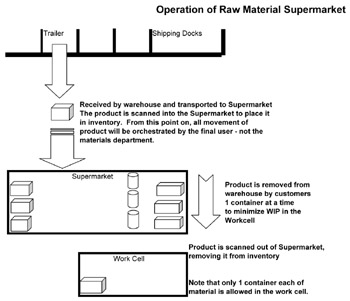Appendix B Kanban Supermarkets
Implementing supermarkets in your plant can be a useful tool for transforming a manufacturing plant from a traditional operation to a pull system. In the traditional operation, raw materials are stored in a warehouse and issued to the floor per an MRP-generated schedule. In essence, a supermarket is a central storage location where raw materials are stored near their point-of-use , so customers can pull them as needed. It works just like the supermarket where you buy your groceries ”hence the name . This system can help:
- Minimize transaction costs
- Facilitate visual management
- Establish the framework to switch to a point-of-use kanban system
It can also be useful in overcoming resistance to a pull system, since it requires the production cells to obtain their own materials versus the materials department delivering it to them in large batches.
The first step in setting up a supermarket is to find a central location to hold the material. If the plant is large, several small supermarkets may be needed. The idea is to set up locations where all of the materials can be stored for easy retrieval as needed. In order to ensure proper stock rotation, the area needs to facilitate the proper flow of materials. Rotation is very important, since production employees will be pulling their own materials from the supermarket, and inventory rotation is not one of their primary concerns.
A simple way to accomplish this rotation is by installing flow lanes (using gravity-fed conveyor racks, if possible). The flow lanes work like this to ensure proper rotation: As materials are received, they are loaded onto the back of the conveyor rack. As needed, the customers then pull them from the front (see Figure B-1).

Figure B-1
In order to make the supermarket and the rotation plan work, it may also be necessary to change some of the containers that materials are shipped in. The containers need to be small enough to be stored in the supermarket and pulled by production as needed. In order to minimize the quantity of materials on the shop floor, the quantity per container should be kept to a reasonable level (one shift's worth or less). This is particularly important if raw materials are issued from the supermarket to the floor. Since your inventory system may not track what has been issued, you want to keep the quantities of WIP to a minimum.
Attention also needs to be placed on keeping track of what is in the supermarket. Since (hopefully) you order your raw materials with a kanban system, the details of what is in the supermarket will mainly be used for financial tracking purposes. (For some suggestions on how to integrate kanban systems with inventory and MRP systems, see Appendix A.) The simplest way to track what is in the warehouse is to set up "supermarket" warehouse locations for each item. As materials are received in the plant, they are transported to and stored in the supermarket. At this point, they are received into the inventory system and scanned into the "supermarket" inventory location. As customers pull materials, they scan them out of the supermarket and into WIP. Thus, you have a simple method of tracking exactly what is in the supermarket. This method can be used with your MRP system or with a simple PC program (see Figure B-1).
Attention also needs to be paid to ensure the supermarket is laid out to allow visual management. Visual management is critical if you are using the supermarket to prepare the plant for the transformation to point-of-use kanbans. Therefore, at a minimum, every part in the supermarket needs to be labeled with:
- Supplier name
- Part number
- Internal customer
- Quantity per container
- Average daily usage
Additionally, visual markings (such as colored zones marked on the floor) and signs can be helpful.
Once a supermarket is installed and running, the transition to a point-of-use kanban system is simple. You can make this transition by building on two basic facts:
- You already have production operators pulling their own materials from the supermarket to keep themselves supplied.
- Your operators are experienced with visual management of their inventory levels.
At this point, follow this two-step process to implement point-of-use kanbans:
- Move each of the raws to its point-of-use (within the production cell ).
- Design and install the kanban system for the production operators to order their own raw materials.
Supermarkets are a big improvement over the traditional warehouse system most companies use, and they facilitate the transition to a pull system. They get production operators into the practice of pulling their own materials as they need them, and they get them used to working with a visual system. Both of these activities can help reduce operator resistance to a pull system, which is critical in the successful transformation from traditional manufacturing to kanban.
Preface
- Introduction to Kanban
- Forming Your Kanban Team
- Conduct Data Collection
- Size the Kanban
- Developing a Kanban Design
- Training
- Initial Startup and Common Pitfalls
- Auditing the Kanban
- Improving the Kanban
- Conclusion
- Appendix A MRP vs. Kanban
- Appendix B Kanban Supermarkets
- Appendix C Two-Bin Kanban Systems
- Appendix D Organizational Changes Required for Kanban
- Appendix E EOQ vs. Kanban
- Appendix F Implementation in Large Plants
- Appendix G Intra-Cell Kanban
- Appendix H Case Study 1: Motor Plant Casting Kanban
- Appendix I Case Study 2: Rubber Extrusion Plant
- Appendix J Abbreviations and Acronyms
EAN: 2147483647
Pages: 142
